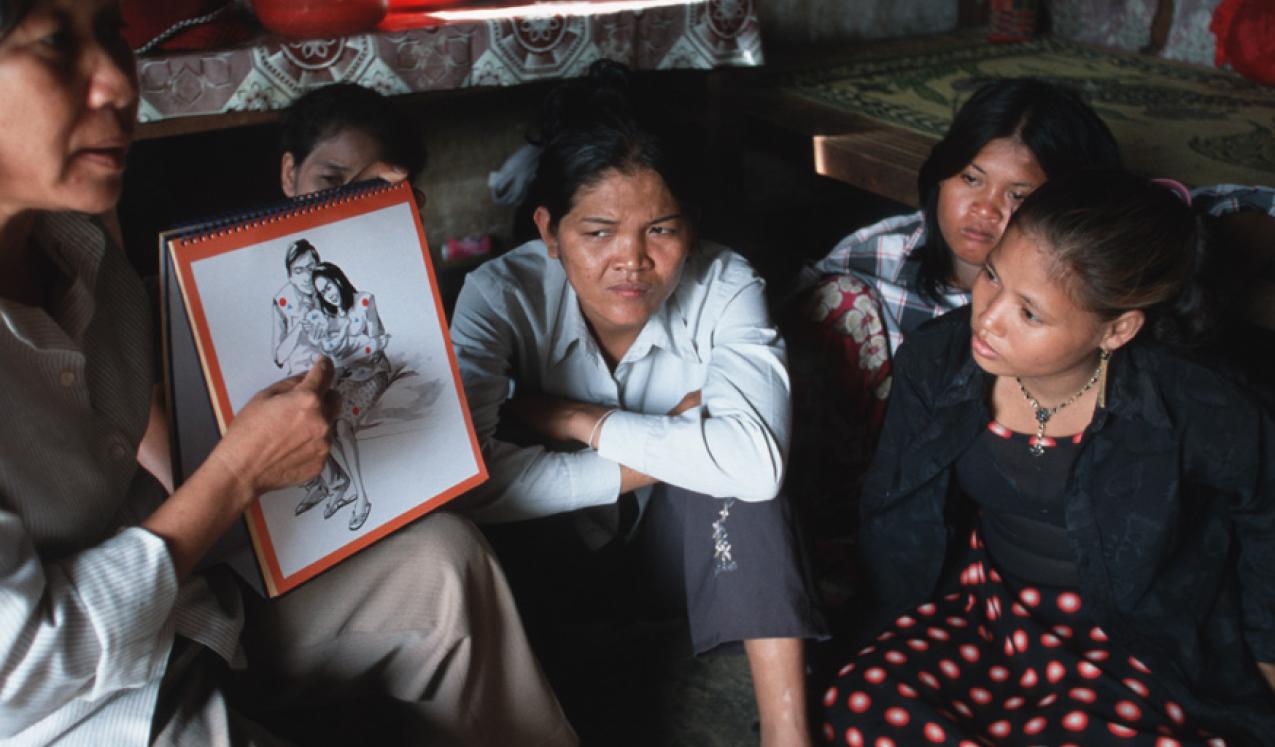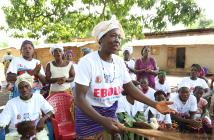
Gender norms and sexual and reproductive health
There is widespread recognition of the importance of gender norms and their application to the field of sexual and reproductive health (SRH), as rigid and traditional gender roles often dictate the terms in which intimate relations, sexual activity and reproduction take place. These norms, which are ubiquitous both globally and across many cultures, place pressure on the individual to conform to pre-conceived expectations of how they should act, behave and interact according to their gender.
Women and girls are conditioned to prioritise purity and modesty in sexual and romantic relationships
Women and girls are conditioned to prioritise purity and modesty in sexual and romantic relationships, while men and boys are encouraged to take more risks and to employ control over their partners. Transgender and gender non-conforming people are often pressured to associate themselves with one particular gender to access appropriate sexual health services and could face punishment if they are unable or unwilling to do so.
An emerging body of research on the effects of gender norm-transformative programmes on health outcomes is available in the literature. In relation to the SRH field, interventions that challenge masculine gender norms are most often focussed on gender-based violence prevention and HIV. These interventions are most effective in small-group participatory settings which encourage critical reflection of unequal gender norms. Furthermore, culturally-held norms about women's reproduction have contributed significantly to an unmet need among women for family planning services. A lack of discussion within couples and limited male involvement are evident across studies in low- and middle-income countries (LMICs).
Meaningful and sustained gender norm change requires interventions that do not only target individual boys, but also incorporate entire communities through a sociological approach.
Women may experience domestic violence or poor health if they take on new norms
The focus of the work to date has been on the impact of gender norm change on men and boys to achieve positive health outcomes for themselves, their female partners and their families. One key explanation for this is that programmes are often situated within their patriarchal contexts, where women may experience domestic violence or poor health if they take on new norms in an inequitable and unchanged environment. As a result, the potential for gender norm change in women lags behind that of men and interventions depend, ultimately, on transformation taking place first in men.
Programmes that target men and adolescent boys most often involved group educational activities (38%), followed by service-based programmes (14%), community outreach (12%) or an integration of different intervention types (36%). Most small focus-group activities involved the use of male facilitators, as this has been shown to be more influential in creating relatability among male participants. Service-based programmes include counselling and usually take place in the context of family planning. Typically, these sessions involve fathers of new-born or small children in one-on-one counselling or with their female partner.
A review by Svanemyr et al. (2015) determined that adolescent boys are instrumental in gender-norm change programming, because attitudes and behaviours are malleable and are more susceptible to influence at a younger age. They also confirmed that conformity with traditional masculinity norms is closely correlated to riskier sexual and health decision-making, the perpetuation of violence and unequal decision-making with women and girls.
Interventions are most often designed to target men and boys
Gender-norm change programmes are implemented most commonly in North America, followed by Latin America and the Caribbean, sub-Saharan Africa and Asia. Interventions are most often designed to target men and boys with the aim of improving the health outcomes and autonomy of women, who are assumed to be their sexual and romantic partners. However, this assumption enforces the idea of heteronormativity: that adherence to masculinity in men and boys is understood as only harmful to women and girls as partners, and not to partners who are other men and boys.
Adherence to strict and traditional gender norms is often measured through the use of gender scales, especially the Gender Equity Men scale (GEM scale). Researchers either use Barker's original scale or use data from the field site to adapt the questionnaire to ensure that it is contextually- and culturally-specific. Researchers will also follow up their intervention with diagnostic testing for the health marker of interest (such as testing for HIV of other sexually transmitted infection (STIs), or testing for pregnancy) or a test of behavioural patterns (such as number of sexual partners, number of abusive episodes against romantic or sexual partner).
The research has consistently found that equitable gender norm attitudes can form in a short timeframe, but that they do not necessarily translate into changed behaviours. This means that many factors that could be employed to achieve more positive health outcomes, such as longer intervention periods, more experienced focus-group leaders and the greater involvement of women to achieve a more significant cultural shift.
Men and adolescent boys, and their association to masculine gender norms, are determined to be harmful to the health status of themselves and to women and girls. Men and adolescent boys who hold more gender inequitable views are more likely to engage in risky sexual behaviours, leading to unprotected sex and higher STI rates for themselves and their sexual partners. There is a clear need to address the potential impact of gender norm transformation on women and girls and their association to feminine gender norms for potentially beneficial health outcomes.
There are many avenues of study for investigators interested in the field of gender-norm change and its relation to sexual and reproductive health. The following section outlines programmes that present good examples of gender-norm transformation. They suggest that interventions that include community-based organising and target the wider social environment were more successful at maintaining change in attitudes and behaviours overtime. However, studies tend to assess only the change in gender equity norms and not its latter impact on health outcomes.
Promoting Healthy Relationships and HIV/STI Prevention for Young Men: Positive Findings from an Intervention Study in Brazil (2004)
Health interventions that seek to curtail the rise of sexually transmitted infections (STIs) in young people have increasingly targeted young men through their programmes. Because traditional gender norms surrounding masculinity emphasise the man as the primary decision-maker in sexual relationships, researchers have used young men as a point of intervention to challenge and re-shape norms as more gender-equitable and gender-aware. Pulerwitz and Barker (2004) studied the relationship between support for gender-inequitable norms and risky sexual behaviours and the early onset of sexual activity. They hypothesised that interventions that promoted gender equity would reduce both STI symptomology and the likelihood of HIV infection.
The study took place in three sites in Rio de Janeiro, Brazil, and used a quasi-experimental design with 780 men and boys aged 14 to 25 exposed to two different intervention types: group-based educational sessions led by adult male facilitators; and group-based educational sessions coupled with a community-wide social marketing campaign that promoted condom use and gender-equitable messaging.
Young men who supported inequitable gender norms were more likely to engage in violence with their partner
The study determined that young men who supported inequitable gender norms were more likely to indicate STI symptomology, lack of contraceptive use, and engage in violence with their primary or recent sexual partner. In both intervention types, symptomology decreased six months after intervention, but the decrease was statistically significant where both group education and community social marketing took place. In additionally, condom use at last sex with a primary partner increased significantly. The researchers found that improvements in sexual health activity were maintained in intervention groups, even a full year after the programme.
CHARM, a gender equity and family planning intervention for men and couples in rural India: protocol for the cluster randomized controlled trial evaluation (2016)
and
Can a Gender Equity and Family Planning Intervention for Men change men’s gender ideology? Results from the CHARM cluster randomized controlled trial in rural India (2018)
Men act as the key decision-makers in their wife's family planning processes in many settings worldwide. In India, women experience a large unmet need for reproductive health services as 1 in 4 pregnancies are unintended, with two-thirds of these found to occur among women who report no modern contraceptive use. Longer spacing between consecutive births has been shown to improve maternal and neonatal health outcomes. However, Yore et al. (2016) identified a lack of research on birth-spacing interventions that accounted for these gendered dynamics.
The researchers developed, implemented and studied a family planning service that exposed married men to gender-equitable messaging in three sessions with village health providers (VHP). The programme, ‘Counselling Husbands to Achieve Reproductive Health and Marital Equity’ (CHARM), was developed through in-depth interviews with married women, men and mothers-in-law to capture the gender norms, behaviours and hierarchies that are present in families when family planning decisions are being made. The CHARM curriculum relied on the standard national public health family planning counselling guide, as well as formative research that emerged during interviews.
The first two sessions were attended by married men and were most often facilitated by a male VHP, in a one-on-one context. The men's wives were invited to attend the third and final session. The men, and later couples, were counselled on the importance of healthy and shared family planning decision-making with pictorial information made available.
The improved views on gender-equity were not sustained over time
The study of this intervention utilised a cluster randomised control trial, with half of the couples assigned to a control group. Survey data were taken at baseline, 9 months post-intervention, and 18 months post-intervention. The results showed that male participants improved their attitudes towards gender-equitable norms significantly between baseline and the 9-month mark, based on their GEM scale scores. The study also found that the CHARM programme had a significant effect on men's attitudes towards household decision-making but had no effect on their gender ideology. The improved views on gender-equity, however, were not sustained over time and plateaued at the 18-month mark.
Interventions to Prevent Unintended and Repeat Pregnancy Among Young People in Low- and Middle-Income Countries: A Systematic Review of the Published and Grey Literature (2016)
Adolescent girls seeking to diminish the likelihood of an unwanted pregnancy face multiple obstacles as a result of gender norms. Girls in low- and middle-income countries (LMICs) are affected disproportionately by unintended pregnancy, lacking access to health services, knowledge and prevention measures. Gender norms dictate that adolescent girls are not supposed to engage in premarital sex in these contexts, as they will be perceived as dishonourable and immoral. One way to combat these rigid gender norms is to addressing their particular health, as targeted interventions respond to an unmet need that is meant to be invisible in society and validate the view that it is acceptable for adolescent girls to engage in safe sexual practices.
Hindin et al. (2016) undertook a systematic review of scientific databases, as well as reports, government documents and working papers, to determine which interventions in LMICs have had the greatest success in decreasing early pregnancy and increasing contraceptive use. They identified a number of evaluated interventions that targeted girls or boys and girls aged 10 to 26 in sub-Saharan Africa, Asia, Latin America and the Caribbean. These were community-, school-, household- and facility-based interventions that used different modalities, including cash transfers, life-skills training, education curricula changes, contraceptive service provision and mass media campaigns.
Of the 16 papers focussing on pregnancy, 9 papers revealed that such interventions had a statistically significant impact on adolescent pregnancy rates. Six programmes showed significant impact on decreasing pregnancy, two showed mixed results and one showed a significant negative impact (demonstrating increasing pregnancy rates).
The interventions with the greatest impact involved cash-transfer components: the first, Oportunidades, took place in Mexico and provided community-wide, conditional cash transfers to girls under 21 years of age who attended school and received sexual and reproductive health education and services. The second programme, a South African social protection programme, was a household-targeted, unconditional cash transfer to boys and girls under 21 years of age living in poverty.
Of the 10 papers focussing on contraceptive use, seven found that interventions showed a statistically significant increase in contraceptive use, one had mixed results and the final two showed significant decrease in contraceptive use. The three most significant interventions included free contraceptive provision and educational materials for boys and girls in China, the provision of contraceptive implants for girls seeking treatment in Kenya and life skills and vocational training for girls in Uganda.
There is no one ‘silver bullet’ to mitigate adolescent pregnancy
These interventions, which aimed to prevent early pregnancy and increase contraceptive use, demonstrate that there is no one ‘silver bullet’ to mitigate adolescent pregnancy. However, each intervention contained at least one component that challenged gender norms. For example, cash-transfer programmes and life skills or vocational training elevate girls' status in society and allow them the resources to be more financially self-sufficient and seek sexual and reproductive health services. Sexual and reproductive health education and contraceptives for young girls and boys acknowledge need among a population that is engaging in sexual activity and is recognised as valid and worthy of service by health providers. Interventions should utilise different components to best address the issue of adolescent pregnancy and should always be rooted in gender-transformative principles.
Community Gender Norms Change as a Part of a Multilevel Approach to Sexual Health Among Married Women in Mumbai, India (2015)
Community mobilisation has often been cited as one of the most effective ways to reshape social norms. As a range of key actors in a given setting coordinate their messaging to change specific normative values, the intended audience begins to synthesise the received information and shift their own internalised social norms accordingly. The literature makes a strong case for the connection between belief in more gender-equitable norms among men and women and the reduction of HIV risk. Schensul et al. (2015) used these ideas to develop a multilevel intervention approach to document community gender norms, use community leaders to disseminate gender equitable messaging, and evaluate the response in the population over time.
The researchers chose a predominantly Muslim community in a slum area of north-eastern Mumbai, India. The study selected a quasi-experimental study design, using a similar community nearby as the control group. The researchers conducted 173 in-depth interviews with married women, men, and couples (aged 21-60) and surveyed 2,408 married men to identify the particular gender norms that were entrenched in the community.
Next, the researchers reached out to two separate community-based bodies that would convey their new, gender-equitable messaging: NGOs working in the area that were providing a variety of services to women and men, and the Muslim clergy (imams) broadcasting sermons to nearly 20,000 men on a weekly basis. The men received both the NGO and religious-based messaging, while the women only received the NGO messaging.
Gender equitable norms increased among the men and women who received the intervention
The study used the GEM scale and found that gender equitable norms had increased among the men and women who received the intervention at the end of three-year period. Interestingly, men reported a far greater positive shift in gender equity scoring than their female counterparts in the intervention group. Furthermore, women in the control group maintained higher gender-equity scoring than women in the intervention groups for two years after the intervention. The researchers explain that this result (men demonstrating greater gender equity norm change than women) could signal the effectiveness of imams in shifting norms in men, especially in gender-segregated settings. The study, however, did not include reporting of health outcomes.



